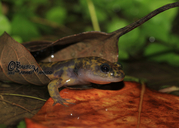|
Paradactylodon persicus (Eiselt & Steiner, 1970)
Subgenus: Paradactylodon | family: Hynobiidae subfamily: Hynobiinae genus: Paradactylodon |
|
Taxonomic Notes: Populations from the far eastern parts of the Elburz Mountains of Iran were long recognized as Paradactylodon gorganensis. Ahmadzadeh, et al. 2020 Amphibia- Reptilia 41:519-534 use mtDNA markers to study goegraphic variation, which is very low. P. gorganensis is nested within P. persicus and is synonymized with it. Dubois and Raffaelli (2012) Alytes 28:77-161 consider the creation of the name Paradactylodon to be invalid and offer a substitute name Iranodon. AmphibiaWeb considers Paradactylodon to be a valid name. |
|
 © 2012 Barbod Safaei (1 of 39) |
|
|
|
Description Distribution and Habitat Country distribution from AmphibiaWeb's database: Iran, Islamic Republic of
Life History, Abundance, Activity, and Special Behaviors Trends and Threats Comments There is debate over whether Paradactylodon persicus, from the eastern edge of the Hyrcanian Corridor, may be conspecific with Paradactylodon gorganensis, from the western Hyrcanian Corridor. Based on morphometric comparisons of topotypic subadults and larvae of both taxa, as well as comparisons with P. mustersi, Batrachuperus pinchonii, and Ranodon sibiricus, Stöck (1999) thought that P. persicus and P. gorganensis might be clinal variants within the same species. However, Ebrahimi et al. (2004) have pointed out that molecular and cytological data, as well as morphometric assessment of the variation throughout the Hyrcanian corridor, are needed to resolve this taxonomic issue.
References
Baloutch, M. and Kami, H. G. (1995). Amphibians of Iran. Tehran University Publishers, Tehran. Ebrahimi, M., Kami, H. G., and Stöck, M. (2004). ''First description of egg sacs and early larval development in hynobiid salamanders (Urodela, Hynobiidae, Batrachuperus) from north-eastern Iran.'' Asiatic Herpetological Research, 10, 168-175. Eiselt, J. and Steiner, H.M. (1970). ''Erstfund eines hynobiiden Molches in Iran.'' Annalen des Naturhistorischen Museums in Wien, 74, 77-90. Kuzmin, S. L. (1999). The Amphibians of the Former Soviet Union. Pensoft, Sofia-Moscow. Kuzmin, S. L., Dodd, C. K., Jr., and Pikulik, M. M. (1995). ''Amphibian populations in the Commonwealth of Independent States: Current status and declines.'' Amphibian Populations in the Commonwealth of Independent States: Current Status and Declines. S. L. C. Kuzmin, C. K. Dodd, Jr., and M. M. Pikulik, eds., PENSOFT Publishers, Sofia, Bulgaria., 159. Schmidtler, J. F., and Schmidtler, J. J. (1971). ''Eine Salamander-Novität aus Persien. Batrachuperus persicus.'' Aquarien-Magazin, 11, 443-445. Steiner, H.M. (1973). ''Beitrage zur Kenntnis von Verbreitung, Okologie und Bionomie von Batrachuperus persicus.'' Salamandra, 9(1), 1-6. Originally submitted by: Sergius L. Kuzmin (first posted 2000-01-21) Edited by: Kellie Whittaker, updated Ann T. Chang (2014-06-23) Species Account Citation: AmphibiaWeb 2014 Paradactylodon persicus <https://amphibiaweb.org/species/3870> University of California, Berkeley, CA, USA. Accessed May 18, 2025.
Feedback or comments about this page.
Citation: AmphibiaWeb. 2025. <https://amphibiaweb.org> University of California, Berkeley, CA, USA. Accessed 18 May 2025. AmphibiaWeb's policy on data use. |


 Map of Life
Map of Life Featured in Amazing Amphibians on 4 November 2013
Featured in Amazing Amphibians on 4 November 2013